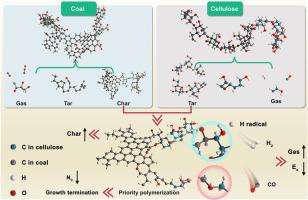Molecular insights into the synergistic effect of co-pyrolysis of low-rank coal and cellulose: Atomic tracking and labeling, interaction mechanisms, and kinetics
IF 6.2
2区 工程技术
Q2 ENERGY & FUELS
引用次数: 0
Abstract
Understanding the synergistic mechanisms between pyrolysis products is crucial for optimizing coal-biomass co-pyrolysis technology. However, the underlying microscopic mechanisms involving complex intermolecular interactions and coupled reaction pathways remain unclear, significantly limiting precise regulation of the process. Hence, this study proposes an atom-tracking and labeling strategy, employing ReaxFF MD simulations to elucidate the structural interactions and synergistic transformation mechanisms between cellulose and low-rank coal during co-pyrolysis. Results show cellulose fragments enhance char yield via crosslinking with coal molecule, while simultaneously inhibiting further polymerization into larger char structures. Moreover, the co-pyrolysis process exhibits a significant synergistic dehydrogenation effect. The generated H radicals recombine to form H2, while attacking oxygenated functional groups in coal to increase gas yield. This contributes to a lower-energy reaction pathway for coal decomposition, resulting in a 24.6 % reduction in the apparent activation energy of coal pyrolysis. The strongest synergistic effects are observed in the 2600–2800 K temperature range. Experimentally determining this temperature range can serve as a critical window for optimizing process parameters in industrial production. This study offers new insights into the synergistic effects of coal-biomass co-pyrolysis and provides a methodological inspiration for analyzing interactions in complex systems.

低阶煤和纤维素共热解协同效应的分子洞察:原子跟踪和标记,相互作用机制和动力学
了解热解产物之间的协同作用机制对于优化煤-生物质共热解技术至关重要。然而,涉及复杂分子间相互作用和耦合反应途径的潜在微观机制仍不清楚,这极大地限制了对该过程的精确调控。因此,本研究提出了一种原子跟踪和标记策略,利用ReaxFF MD模拟来阐明纤维素和低阶煤在共热解过程中的结构相互作用和协同转化机制。结果表明,纤维素片段通过与煤分子交联提高了炭产率,同时抑制了进一步聚合成更大的炭结构。此外,共热解过程表现出显著的协同脱氢效应。生成的H自由基重新结合形成H2,同时攻击煤中的含氧官能团,提高产气量。这使得煤的分解反应路径能量更低,导致煤热解表观活化能降低24.6%。在2600 ~ 2800 K温度范围内,协同效应最强。通过实验确定该温度范围可以作为优化工业生产过程参数的关键窗口。该研究为煤-生物质共热解的协同效应提供了新的见解,并为分析复杂系统中的相互作用提供了方法上的启发。
本文章由计算机程序翻译,如有差异,请以英文原文为准。
求助全文
约1分钟内获得全文
求助全文
来源期刊

Journal of The Energy Institute
工程技术-能源与燃料
CiteScore
10.60
自引率
5.30%
发文量
166
审稿时长
16 days
期刊介绍:
The Journal of the Energy Institute provides peer reviewed coverage of original high quality research on energy, engineering and technology.The coverage is broad and the main areas of interest include:
Combustion engineering and associated technologies; process heating; power generation; engines and propulsion; emissions and environmental pollution control; clean coal technologies; carbon abatement technologies
Emissions and environmental pollution control; safety and hazards;
Clean coal technologies; carbon abatement technologies, including carbon capture and storage, CCS;
Petroleum engineering and fuel quality, including storage and transport
Alternative energy sources; biomass utilisation and biomass conversion technologies; energy from waste, incineration and recycling
Energy conversion, energy recovery and energy efficiency; space heating, fuel cells, heat pumps and cooling systems
Energy storage
The journal''s coverage reflects changes in energy technology that result from the transition to more efficient energy production and end use together with reduced carbon emission.
 求助内容:
求助内容: 应助结果提醒方式:
应助结果提醒方式:


